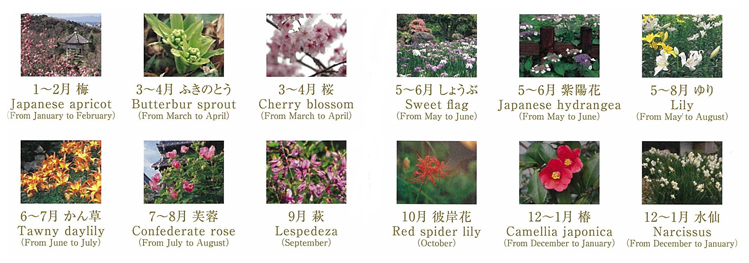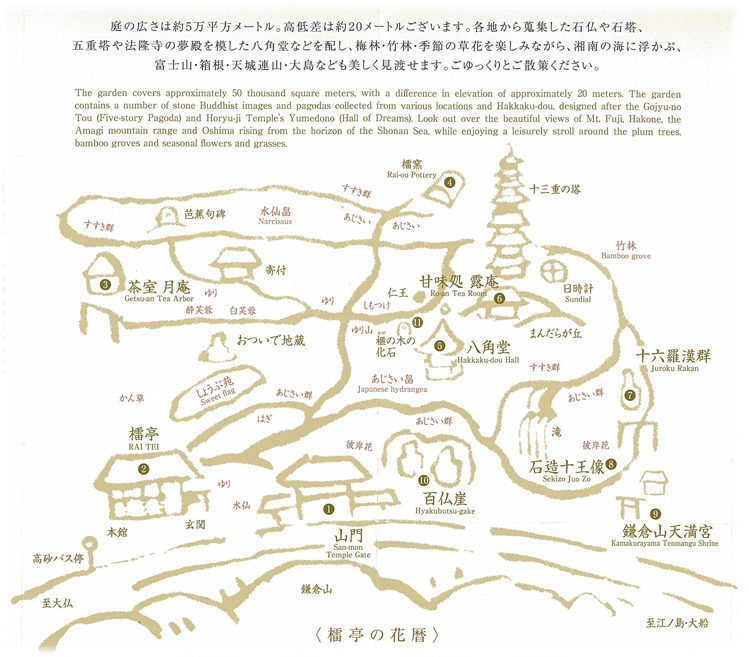

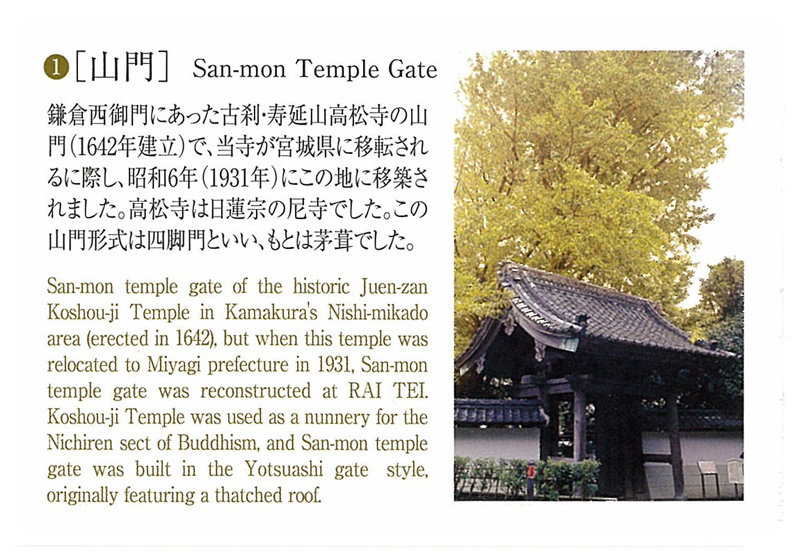
鎌倉西御門にあった古刹・寿延山高松寺の山門(1642年建立)で、当寺が宮城県に移転されるに際し、昭和6年(1931年)にこの地に移築されました。高松寺は日蓮宗の尼寺でした。この山門形式は四脚門といい、もとは茅葺でした。
1 San-mon Temple Gate
San-mon temple gate of the historic Juen-zan Koshou-ji Temple in Kamakura’s Nishi-mikado area (erected in 1642), but when this temple was relocated to Miyagi prefecture in 1931, San-mon temple gate was reconstructed at RAI TEI. Koshou-ji Temple was used as a nunnery for the Nichiren sect of Buddhism, and San-mon temple gate was built in the Yotsuashi gate style, originally featuring a thatched roof.
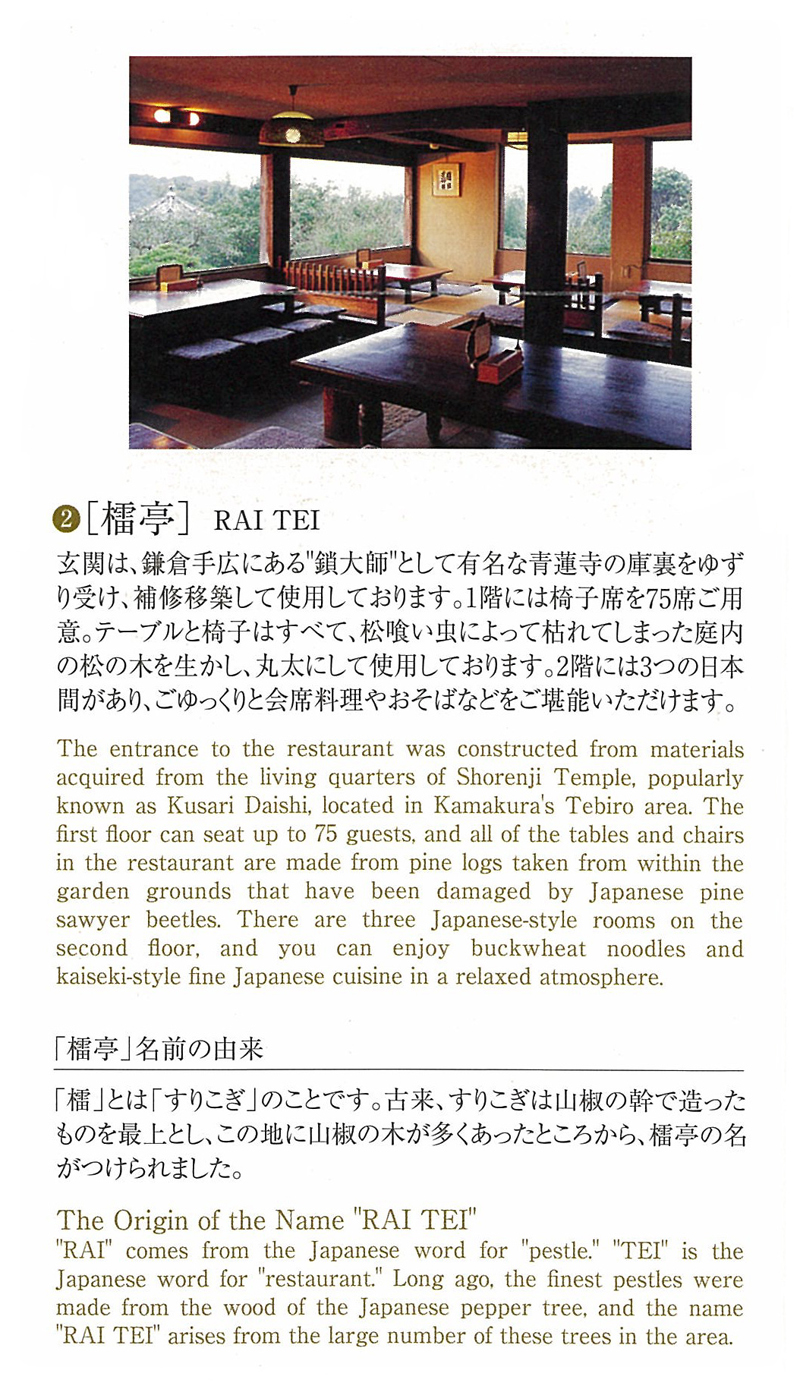
玄関は、鎌倉手広にある“鎖大師”として有名な青蓮寺の庫裏をゆずり受け、補修移築して使用しております。1階には椅子席を75席ご用意。テーブルと椅子はすべて、松喰い虫によって枯れてしまった庭内の松の木を生かし、丸太にして使用しております。2階には3つの日本間があり、ごゆっくりと会席料理やおそばなどをご堪能いただけます。
2 RAI TEI
The entrance to the restaurant was constructed from materials acquired from the libing quarters of Shorenji Temple, popularly known as Kusari Daishi, located in Kamakura’s Tebiro area. The first floor can seat up 75 guestes, and all of the tables and chairs in the restaurant are made from pine logs taken from within the garden grounds that have been damaged by Japanese pine sawyer beetles. There are three Japanese-style rooms on the second floor, and you can enjoy buckwheat noodles and kaiseki-style fine Japanese cuisine in a relaxed atmosphere.
「檑亭」名前の由来
「檑」とは「すりこぎ」のことです。古来、すりこぎは山椒の幹で造ったものを最上とし、この地に山椒の木が多くあったところから、檑亭の名がつけられました。
The Origin of the Name “RAI TEI”
“RAI” comes from the Japanese word for “pestle”. “TEI” is the Japanese word for “restaurant”. Long ago, the finest pestles were made from the wood of the Japanese pepper tree, and the name “RAI TEI” arises from the large number of these trees in the area.
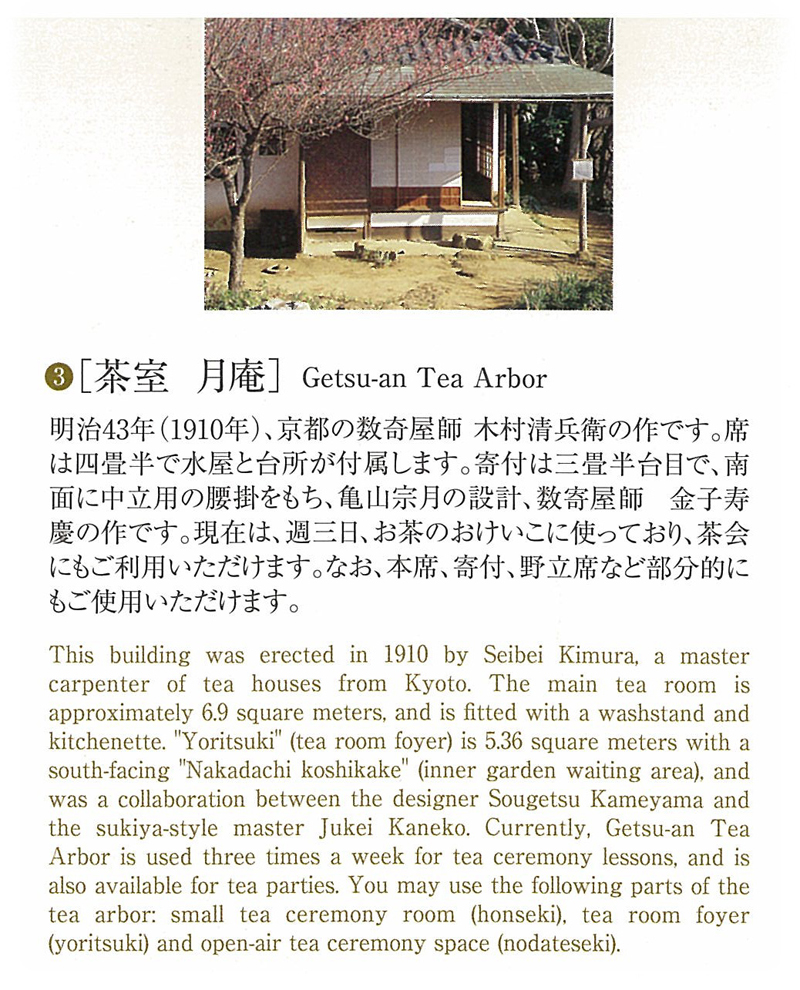
明治43年(1910年)、京都の数寄屋師 木村清兵衛の作です。席は四畳半で水屋と台所が付属します。寄付は三畳半台目で、南面に中立用の腰掛をもち、亀山宗月の設計、数寄屋師 金子寿慶の作です。現在は、週三日、お茶のお稽古に使っており、茶会にもご利用いただけます。なお、本席、寄付、野立席など部分的にもご使用いただけます。
3 Getsu-an Tea Arbor
This building was erected in 1910 by Seibei Kimura, a master carpenter of tea houses from Kyoto. The main tea room is approximately 6.9 square meters, and is fitted with a washstand and kitchenette. “Yoritsuki” (tea room foyer) is 5.36 square meters with a south-facing “Nakadachi koshikake” (inner garden waiting area), and was a collaboration between the designer Sougetus Kameyama and the sukiya-style master Jukei Kaneko. Currently, Getsu-an Tea Arbor is used three times a week for tea ceremony lessons, and is also available for tea parties. You may use the following parts of the tea arbor: small te ceremony room (honseki), tea room foyer (yoritsuki) and open-air tea ceremony space (nodateseki).
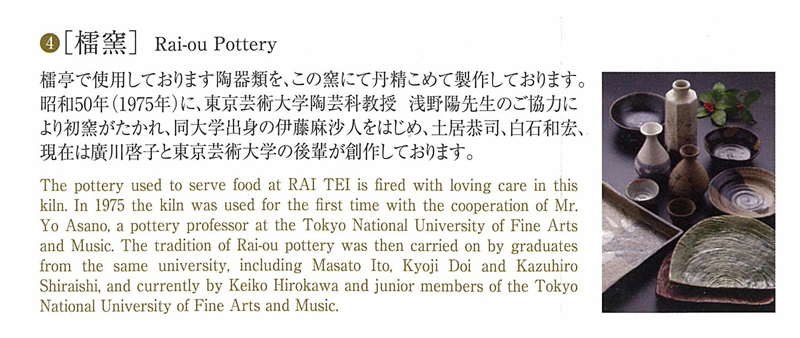
檑亭で使用しております陶器類を、この窯にて丹精こめて製作しております。昭和50年(1975年)に東京芸術大学陶芸科教授 浅野陽先生のご協力により初窯がたかれ、同大学出身の伊藤麻沙人をはじめ、土井恭司、白石和宏、現在は廣川啓子と東京芸術大学の後輩が創作しております。
4 Rai-ou Pottery
The pottery used to serve food at RAI TEI is fired with loving care in this kiln. In 1975 the kiln was used for the first time with the cooperation of Mr. Yo Asano, a pottery professor at the Tokyo National University of Fine Arts and Music. The tradition of Rai-ou pottery was then carrid on by graduates from the same university, including Masato Ito, Kyoji Doi and Kazuhiro Shiraishi, and currently by Keiko Hirokawa and junior members of the Tokyo National University of Fine Arts and Music.
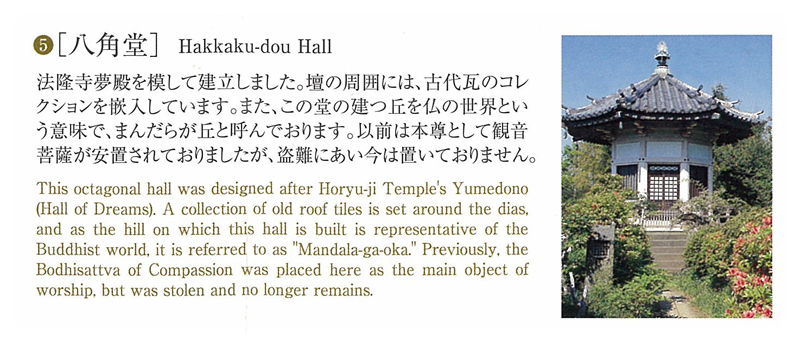
法隆寺夢殿を模して建立しました。壇の周囲には、古代瓦のコレクションを嵌入しています。また、この堂の建つ丘を仏の世界という意味で、まんだらが丘と呼んでおります。以前は本尊として観音菩薩が安置されておりましたが、盗難にあい今は置いておりません。
5 Hakkaku-dou Hall
This octagonal hall was designed after Horyu-ji Temple’s Yumedono (Hall of Dreams). A collection of old roof tiles is set around the dias, and as the hill on which this hall is built is representative of the Buddhist world, it is referred to as “Mandala-ga-oka”. Previously, the Bodhisattva of Compassion was placed here ad the main object of worship, but was stoken and no longer remains.
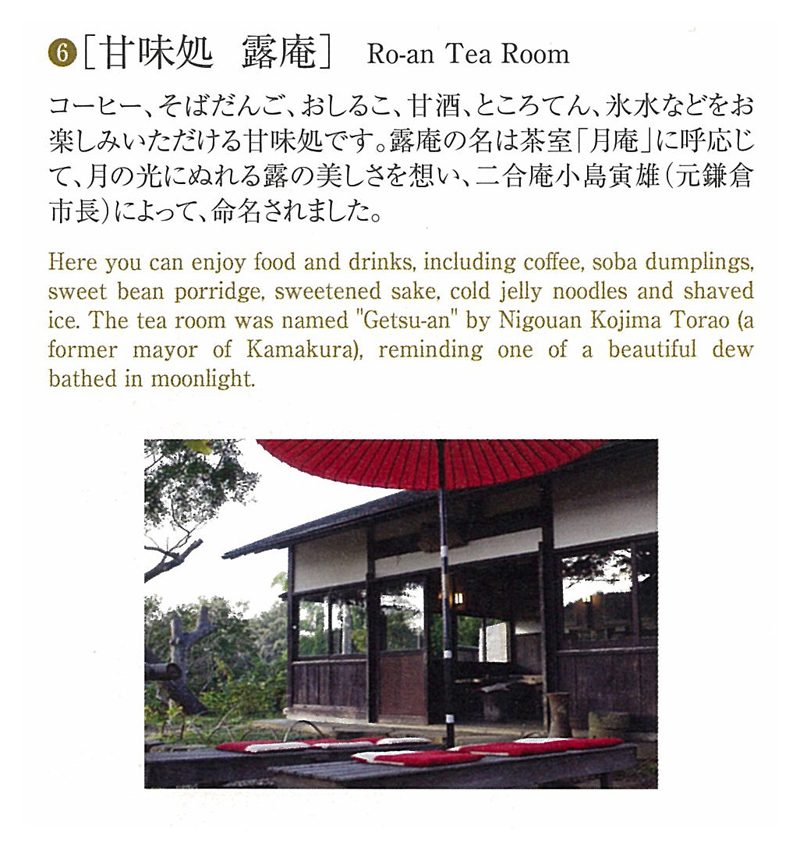
コーヒー、そばだんご、おしるこ、甘酒、ところてん、氷水などをお楽しみいただける甘味処です。露庵の名は茶室「月庵」に呼応じて、月の光にぬれる露の美しさを想い、二合庵島寅雄(元鎌倉市長)によって、命名されました。
6 Ro-an Tea Room
Here you can enjoy food and drinks, including coffee, soba dumplings, sweet bean porridge, sweetened sake, cold jelly noodles and shaved ice. The tea room was named “Getsu-an” by Nigouan Kojima Torao (a former mayor of Kamakura), reminding one of a beautiful dew bathed in moonlight.
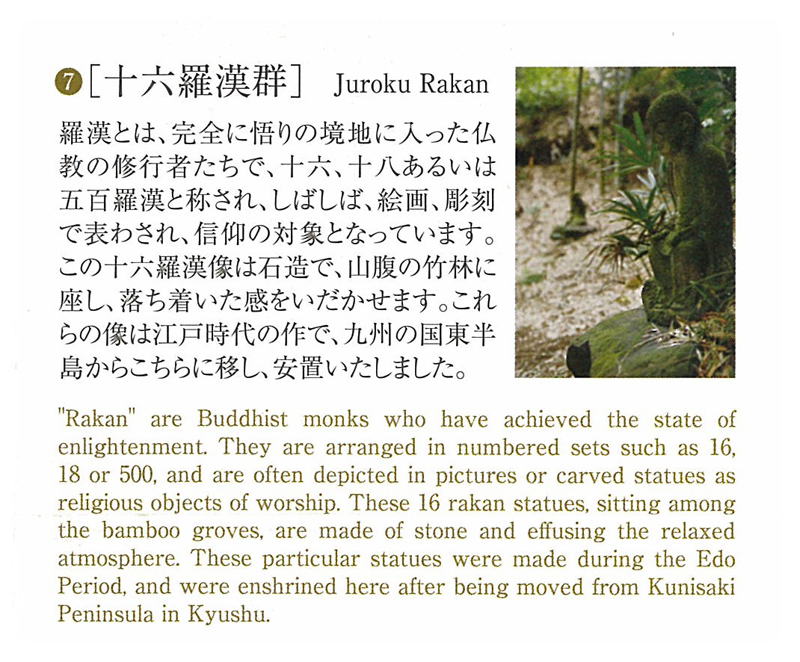
羅漢とは、完全に悟りの境地に入った仏教の修行者たちで、十六、十八あるいは五百羅漢と称され、しばしば、絵画、彫刻であらわされ、信仰の対象となっています。この十六羅漢像は石造で、山腹の竹林に座し、落ち着いた感をいだかせます。これらの像は江戸時代の作で、九州の国東半島からこちらに移し、安置いたしました。
7 Juroku Rakan
“Rakan” are Buddhist monks who have achieved the state of enlightenment. They are arranged in numbered sets such as 16, 18 or 500, and are often depiceted in pictures or carved statues as religious objects of worship. These 16 rakan statues, sitting among the bamboo groves, are made of stone and effusing the relaxed atmosphere. These particular statues were made during the Edo Period, and were enshrined here after being moved from Kunisaki Peninsula in Kyushu.
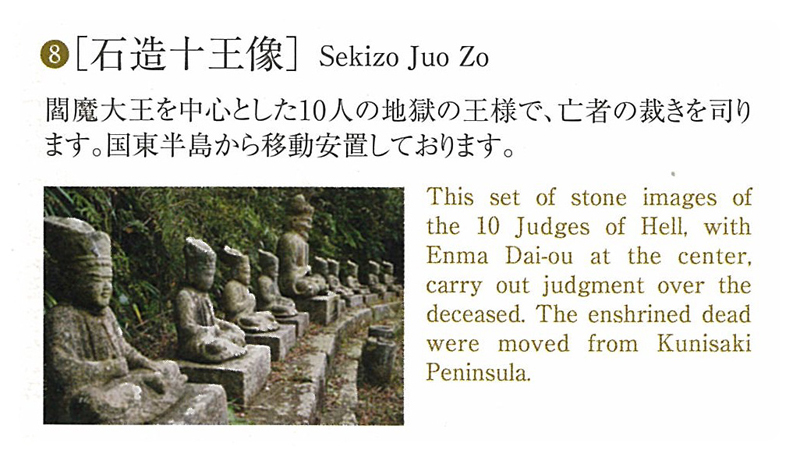
閻魔大王を中心とした10人の地獄の王様で、亡者の裁きを司ります。国東半島から移動安置しております。
8 Sekizo Juo Zo
This set of stone images of the 10 Judges of Hell, with Enma Dai-ou at the center, carry out judgment over the deceased. The enshrined dead were moved from Kunisaki Peninsula.
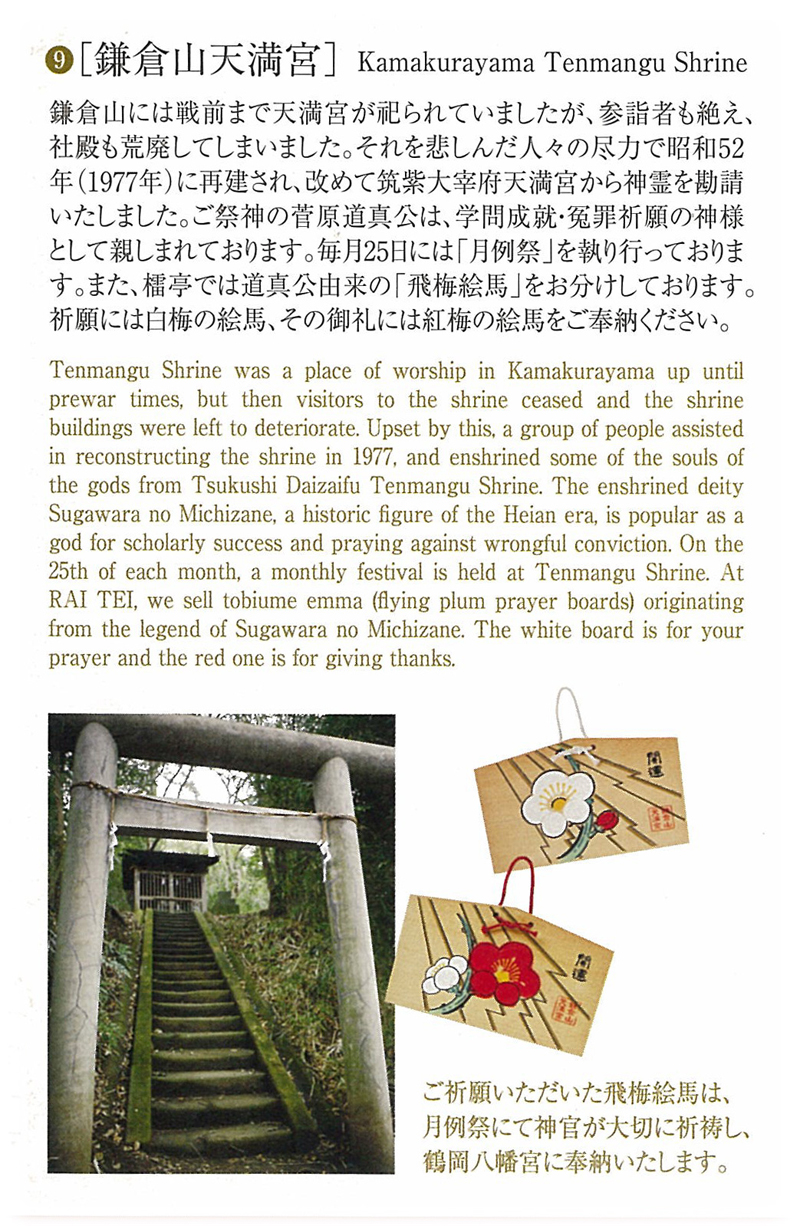
鎌倉山には戦前まで天満宮が祀られていましたが、参詣者も絶え、社殿も荒廃してしまいました。それを悲しんだ人々の尽力で昭和52年(1977年)に再建され、改めて筑紫大宰府天満宮から神霊を勘請いたしました。ご祭神の菅原道真公は、学問成就・冤罪祈願の神様として親しまれております。毎月25日には「月例祭」を執り行っております。また、檑亭では道真公由来の「飛梅絵馬」をお分けしております。祈願には白梅の絵馬、その御礼には紅梅の絵馬をご奉納ください。
9 Kamakurayama Tenmangu Shrine
Tenmangu Shrine was a place of worship in Kamakurayama up until prewar times, but then visitors to the shrine ceased and the shrine buildings were left to deteriorate. Upset by this, a group of people assisted in reconstructing the shrine in 1977, and enshrined some of the souls of the gods from Tsukushi Daizaifu Tenmangu Shrine. The enshrined deity Sugawara no Michizane, a historic figure of the Heian era, is popular as a god for scholarly success and praying against wrongful conviction. On the 25th of each month, a monthly festival is held at Tenmangu Shrine. At RAI TEI, we sell tobiume emma (flying plum prayer boards) originating from the legend of Sugawara no Michizane. The white board is for your prayer and the red one is for giving thanks.
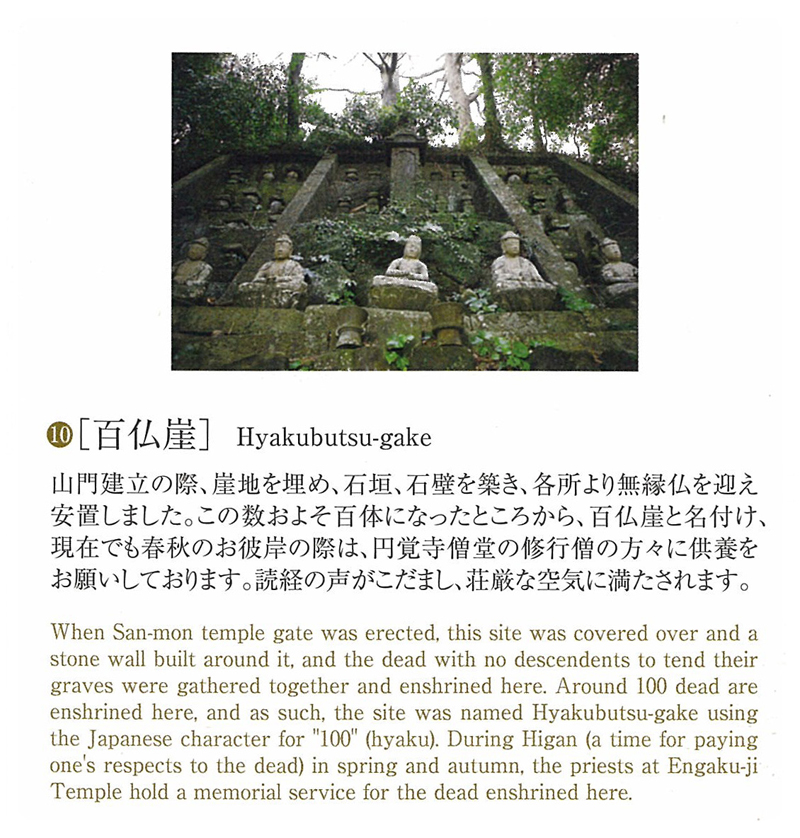
山門建立の際、崖地を埋め、石垣、石壁を築き、各所より無縁仏を迎え安置しました。この数およそ百体になったところから、百仏崖と名付け、現在でも春秋のお彼岸の際は、円覚寺僧堂の修行僧の方々に供養をお願いしております。読経の声がこだまし、荘厳な空気に満たされます。
10 Hyakubutsu-gake
When San-mon temple gate was erected, this site was covered over and a stone wall built around it, and the dead with no descendents to tend their graves were gathered together and enshrined here. Around 100 dead are enshrined here, and as such, the site was named Hyakubutsu-gate using the Japanese character for “100” (hyaku). During Higan (a time for paying one’s respects to the dead) in spring and autumn, the priests at Engaku-ji Temple hold a memorial service for the dead enshrined here.
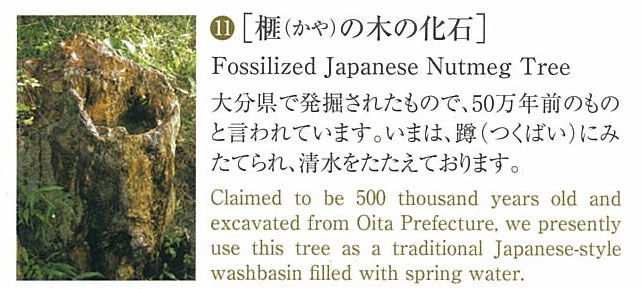
大分県で発掘されたもので、50万年前のものと言われています。いまは、蹲(つくばい)にみたてられ、清水をたたえております。
11 Fossilized Japanese Nutmeg Tree
Claimed to be 500 thousand years old and excavated from Oita Prefecture, we presently use this tree as a traditional Japanese-style washbasin filled with spring water.
